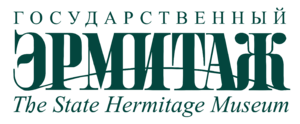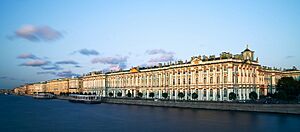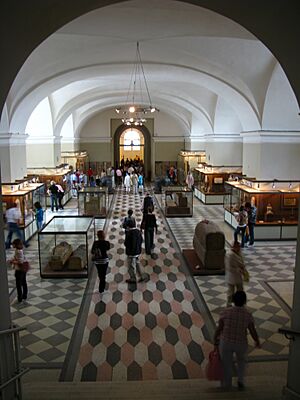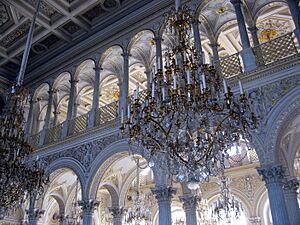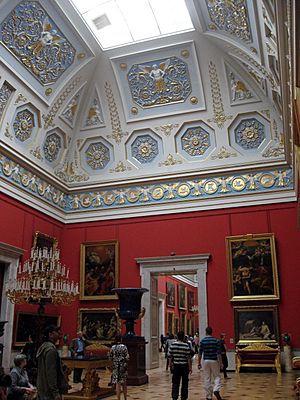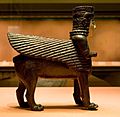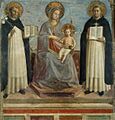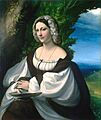Hermitage Museum facts for kids
The State Hermitage Museum is a huge museum of art and culture in Saint Petersburg, Russia. It holds one of the largest collections of paintings in the world. Imagine over three million items, including ancient artifacts, famous paintings, and beautiful sculptures!
The museum started in 1764. Empress Catherine the Great bought a large collection of paintings. The Hermitage celebrates its birthday every year on December 7th. It first opened its doors to the public in 1852. In 2022, nearly three million people visited this amazing place.
The Hermitage is made up of six historic buildings. These include the famous Winter Palace, which used to be home to Russian emperors. Other buildings are the Small Hermitage, Old Hermitage, New Hermitage, and Hermitage Theatre. The museum also has other locations, like the General Staff Building.
If you visit, you can get in for free on the third Thursday of every month. Students and children can enter for free every day. The museum is closed on Mondays. The current director, Mikhail Piotrovsky, has led the museum since 1992.
Contents
What Does "Hermitage" Mean?
The word "Hermitage" comes from an old French word meaning "hermit" or "recluse." A hermit is someone who lives alone. The museum got its name because, at first, Empress Catherine the Great kept her art collection in a private place. It was like her own quiet retreat.
Amazing Buildings of the Hermitage
The Hermitage Museum is not just one building. It's a group of grand buildings along the Neva River. It started with the "Small Hermitage" building. Over time, it grew to include many more.
Today, the museum complex includes:
- The Winter Palace: This was once the main home of the Russian tsars (emperors).
- The Small Hermitage
- The Old Hermitage (also called the Large Hermitage)
- The New Hermitage
- The Hermitage Theatre
- Parts of the General Staff Building
- The Menshikov Palace
These buildings are beautiful works of art themselves. They show different styles of architecture from over the centuries.
Incredible Art Collections
The Hermitage Museum has art from all over the world and from many different times. You can see paintings, sculptures, and decorative items.
Ancient Egyptian Treasures
Step back in time to Ancient Egypt! This collection has artifacts from as far back as 1852. You can find these ancient treasures in a large hall on the ground floor of the Winter Palace.
Greek and Roman Art
The museum has a huge collection of Classical antiquities. These are ancient Greek and Roman artworks. You can see Greek pottery, sculptures, and jewelry from thousands of years ago. There are also Roman statues and art.
One amazing item is the Kolyvan Vase. It's 2.57 meters (about 8.4 feet) tall and weighs 19 tons! That's like a small truck! It was made from jasper in 1843.
Prehistoric Finds
Discover what life was like before written history! The prehistoric collection includes items from the Stone Age to the Iron Age. These artifacts were found all over Russia. You can see ancient carpets and a well-preserved wooden chariot from over 2,000 years ago.
Sparkling Jewelry and Decorative Arts
The Hermitage has special "treasure galleries." Here, you can see amazing jewelry from ancient times to the early 1900s. There's also gold from ancient tribes.
Don't miss the Pavilion Hall! It has the famous 18th-century golden Peacock Clock. This clock is a mechanical wonder that still works today.
Italian Renaissance Masterpieces
Travel to Italy during the Renaissance! This section features works by famous Italian artists. You can see paintings by Giorgione, Titian, and Veronese. The museum also has two famous paintings, Benois Madonna and Madonna Litta, which are thought to be by Leonardo da Vinci or his students.
Other Italian Renaissance art includes Conestabile Madonna and Madonna with Beardless St. Joseph by Raphael.
Spanish and Italian Art
The New Hermitage has rooms with red walls and skylights. Here, you'll find Italian and Spanish paintings from the 1500s to the 1700s. Look for works by Velázquez and Murillo.
Knights' Hall: Arms and Armor
Imagine knights in shining armor! The Knights' Hall displays a collection of Western European arms and armor. These pieces date from the 1400s to the 1600s.
Nearby, you can see beautiful marble sculptures by Antonio Canova. One famous sculpture is The Three Graces.
Dutch and Flemish Art
Explore the art of the 1600s from the Netherlands and Flanders. The Hermitage has many paintings by famous artists like Van Dyck, Rubens, and Rembrandt.
The "Rubens Room" is dedicated to the works of Peter Paul Rubens.
French Impressionists and Modern Art
The museum also has a fantastic collection of French art. This includes Impressionist and post-Impressionist paintings. You can see works by Monet, Van Gogh, Renoir, and Gauguin.
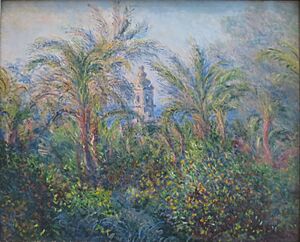
Modern art is displayed in the General Staff Building. Here, you'll find paintings by Matisse, Picasso, and Kandinsky.
A Look at History
The Hermitage Museum has a rich and interesting history.
Catherine the Great's Vision
Empress Catherine the Great started the museum's collection in 1764. She bought many paintings from a merchant in Berlin. Her first purchase included works by famous artists like Rembrandt and Rubens. Some of these paintings, like Rembrandt's Danaë, are still in the Hermitage today.
Catherine loved collecting art. She wanted Russia to be seen as an important cultural center in Europe. She even saw herself as "Catherine the Minerva," like the Roman goddess of wisdom and arts.
Her collection grew so fast that new buildings had to be built. The Small Hermitage and the Old Hermitage were created to house her treasures. She also built her own private theater, the Hermitage Theatre.
Growing Through the Centuries
Over the years, the collection continued to expand.
- In 1815, Alexander I of Russia bought more paintings, including some by Antonio Canova.
- In the 1840s, Nicholas I decided to open a public museum. The New Hermitage was built for this purpose. It opened to the public on February 5, 1852.
- More collections were added, including ancient artifacts and medieval art.
- In 1914, Leonardo da Vinci's Benois Madonna joined the collection.
After the Russian Revolution
After the Russian Revolution in 1917, the Imperial Hermitage and the Winter Palace became state museums. Many private art collections from royal palaces were added to the Hermitage.
However, during the 1930s, the Soviet government sold some valuable artworks. This was done to raise money for the country. Famous paintings like Raphael's Alba Madonna were sold to foreign buyers.
During World War II, when Germany invaded the Soviet Union, many artworks were moved to safety. They were evacuated by train to a city called Sverdlovsk (now Yekaterinburg). The museum buildings were damaged during the Siege of Leningrad. After the war, the collections returned, and the museum reopened in 1945.
In 1948, the Hermitage received a large collection of Impressionist and modern art. These included works by Matisse and Picasso.
In 1985, a man attacked Rembrandt's painting Danaë with acid and a knife. Museum experts worked for years to restore it. Today, it is displayed behind protective glass.
The Hermitage Today
Since 1991, the Hermitage has continued to grow and change.
- In the 1990s, it was revealed that the museum held some paintings taken from Germany after World War II. These were later displayed in an exhibition called Hidden Treasures Revealed.
- The museum expanded into the eastern wing of the General Staff Building in 1993.
- In 2006, some smaller items were stolen from the museum. Many of these were later recovered.
- In 2020, Apple filmed a continuous 5-hour video inside the museum using an iPhone. It showed off the art, architecture, and even live performances.
Hermitage Around the World
The Hermitage Museum has also created partnerships and exhibition centers in other cities and countries.
Hermitage-Kazan Exhibition Center
This center opened in 2005 in Kazan, Russia. It's located in the historic Kazan Kremlin.
Hermitage-Vyborg Center
Another center opened in 2010 in Vyborg, Russia.
Former International Locations
The Hermitage used to have exhibition spaces in other countries.
- The Guggenheim Hermitage Museum in Las Vegas, USA, was open from 2001 to 2008.
- The Hermitage Rooms in London, UK, were open from 2000 to 2007.
- The Hermitage Amsterdam in the Netherlands was a large branch. It opened in 2009. However, in 2022, it ended its ties with the St. Petersburg museum and was renamed the H'ART Museum.
Who Runs the Hermitage?
The museum is managed by a director. The current director is Mikhail Piotrovsky.
Volunteer Service
The Hermitage has a special Volunteer Service. Volunteers help the museum with many tasks. They also help connect the museum's experts with the public.
The Hermitage Cats
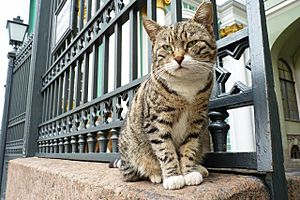
Did you know that cats live at the Hermitage Museum? They are a special part of the museum's history and are loved by visitors. They even help protect the artworks by keeping mice away!
Images for kids
-
Ancient Near East: Urartu deity (7th–5th century BC)
-
Ancient Steppes: Pazyryk horseman (3rd century BC)
-
Hellenistic: Gonzaga Cameo (3rd century BC)
-
Ancient Roman: Bust of Lucius Verus (160–170)
-
Indian: statue of Buddha (2nd–3rd century)
-
Gothic: Anjou Legendarium (1330)
-
Early Renaissance: Madonna and Child with St Dominic and St Thomas Aquinas by Fra Angelico (c. 1435)
-
Early Renaissance: Madonna Litta by Leonardo da Vinci (c. 1490)
-
Mannerism: Saint Peter and Saint Paul by El Greco (1592)
-
Italian Baroque: The Lute Player by Caravaggio (1596)
-
Italian Baroque: The Martyrdom of Saint Catherine by Guercino (1653)
-
Spanish Baroque: The Lunch by Diego Velázquez (1617)
-
Spanish Baroque: Rest on the Flight into Egypt by Bartolomé Esteban Murillo (c. 1665)
-
Classicism: Tancred and Herminia by Nicolas Poussin (1649)
-
Dutch Baroque: The Descent from the Cross by Rembrandt (1634)
-
Dutch Baroque: The Return of the Prodigal Son by Rembrandt (1661–1669)
-
English: Woman in Blue by Thomas Gainsborough (c. 1770s)
-
Rococo: The Stolen Kiss by Jean-Honoré Fragonard (c. 1780)
-
Rococo: Actors of the Comédie-Française by Antoine Watteau (c. 1711–1718)
-
Romanticism: Portrait of Antonia Zarate by Francisco Goya (1810)
-
Romanticism: On the Sailing Boat by Caspar David Friedrich (1819)
-
Impressionism: Woman in the Garden by Claude Monet (1867)
-
Impressionism: Place de la Concorde by Edgar Degas (1875)
-
Post-Impressionism: Memory of the Garden at Etten (Ladies of Arles) by Vincent van Gogh (1888)
-
Post-Impressionism: The Overture to Tannhauser by Paul Cézanne (1868)
-
Picasso's Rose Period: Femme au café (Absinthe Drinker) by Pablo Picasso (1901–02)
-
Proto-Cubism: Dryad, by Pablo Picasso (1908)
-
Maratha India: A Maratha Armor and Helmet
-
Abstract: Composition VI by Wassily Kandinsky (1913)
-
Hall of Iran, Hermitage Museum, Saint Petersburg, Russia
-
Hermitage Museum, Saint Petersburg, Russia
-
Hall of Iran, Hermitage Museum, Saint Petersburg, Russia
-
Hermitage Museum, Saint Petersburg, Russia
-
Hermitage Museum, Saint Petersburg, Russia
-
Hermitage Museum, Saint Petersburg, Russia
-
Hermitage Museum, Saint Petersburg, Russia
-
Hermitage Museum, Saint Petersburg, Russia
-
Hermitage Museum, Saint Petersburg, Russia
-
Hermitage Museum, Saint Petersburg, Russia
-
Hermitage Museum, Saint Petersburg, Russia
-
Hermitage Museum, Saint Petersburg, Russia
-
Hermitage Museum, Saint Petersburg, Russia
-
Hermitage Museum, Saint Petersburg, Russia
-
Hermitage Museum, Saint Petersburg, Russia
-
Hermitage Museum, Saint Petersburg, Russia
-
Hermitage Museum, Saint Petersburg, Russia
-
Hermitage Museum, Saint Petersburg, Russia
-
Hermitage Museum, Saint Petersburg, Russia
-
Hermitage Museum, Saint Petersburg, Russia
-
Hermitage Museum, Saint Petersburg, Russia
-
Hall of Egypt, Hermitage Museum, Saint Petersburg, Russia
-
Hall of Egypt, Hermitage Museum, Saint Petersburg, Russia
See also
 In Spanish: Museo del Hermitage para niños
In Spanish: Museo del Hermitage para niños


